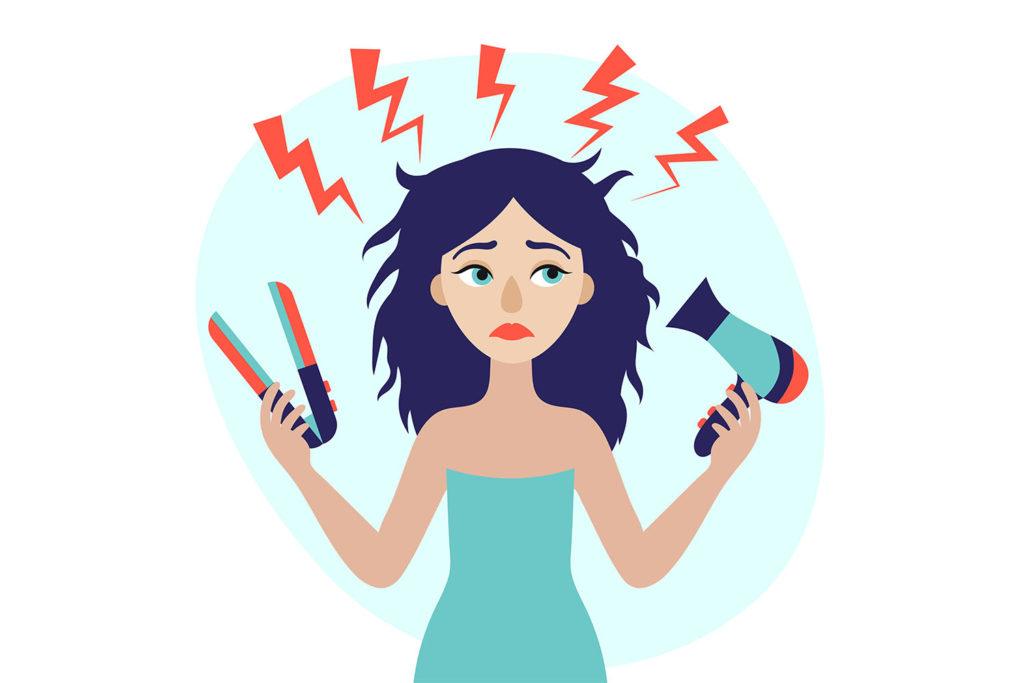Pure Excellence Hair Design Knows How to Maintain Healthy Hair
This month, Pure Excellence wants to share tips on how to protect your hair from heat damage. When we say “heat damage,” we mean damage that results from using hot styling devices. While we encourage styling with a blow dryer and a flatiron or curling iron, these can damage your hair long-term. To maintain hair healthy and still use heat to style it, we recommend you:
- Wash your hair with high-quality conditioner
- Use moisturizer and apply heat protectant
- Let hair air dry when possible
- Blow-dry on low heat
- Get regular trims as often as possible
When Washing Your Hair, Use High-Quality Conditioner and Shampoo
The first defense against heat damage is in the shower. When deciding on products to use to clean your hair, you want to use high-quality conditioners and shampoos. This means finding ones free of sulfates, parabens, and other ingredients that can leave hair dry and brittle. In November 2021, we shared several tips about protecting your hair’s sebum and treating dryness. We explained that sulfates strip your hair of its natural sebum, an oil that makes it shiny and healthy. Among those tips included using hair care products with humectants, like aloe, and emollients, like shea butter.
Use Moisturizers and Hair Masks, and Apply Heat Protectant
Using high-quality conditioners and shampoos is only the first step in preventing heat damage. You should also use moisturizers, like hair masks. Additionally, we recommend you apply heat protectants.
Why You Should Use Moisturizer
Just like face masks hydrate and nourish skin, hair masks boost hair’s overall health. You apply hair masks after shampooing but before conditioning. Leave the hair mask on for three to 20 minutes, then rinse it off. You should limit using a hair mask to once per week. The term “deep conditioning treatment” at a salon usually means the hairdresser will use moisturizer, such as a hair mask.
You can purchase hair masks at stores or online that have natural ingredients like oils and plant extracts. If you want make your own, you don’t have to look farther than your pantry. According to healthline.com, effective moisturizers to use include bananas, honey, egg yolks, coconut oil, and olive oil.
Heat Protectant Basics
When applying heat protectant, it adds a barrier between your hair and blow-dryer or styling irons (curling, flat, etc.) This barrier seals in moisture and prevents frizz. Heat protectants also smooth the hair’s cuticle, making it look smooth and feel soft. You can choose from a variety of heat protectants at the store, from salons, or online. If you want to use a natural heat protectant, you can use:
Coconut Oil
This is the most popular natural heat protectant option available. Because coconut oil can make your hair a little oily, we suggest applying only a few drops. After applying it to your hair strands, comb it through with your fingers, starting at the mid-shaft. Avoid applying it to your roots.
Other Oils
In addition to coconut, argon, almond, sunflower, and grapeseed oil also work as heat protectants. Grapeseed and argon oil have relatively high smoke points —420ºF. Almond oil’s smoke point is 430ºF and sunflower oil’s smoke point is 440ºF. You can also mix avocado oil and shea butter.
Shea Butter
Shea butter can serve as a heat protectant and for when you want to use moisturizer. It has a high smoke point and creates a heat barrier similar to products that contain silicone. All you need is a dime-sized amount, or smaller, as shea butter is heavy. To use it with avocado oil as a base, mix half a cup shea butter with two tablespoons avocado oil.
Let Hair Air Dry When Possible or Blow Dry on Low Heat if Styling
As mentioned in our November blog, heat usually damages hair on the surface, as well as the cuticle layers. To avoid this kind of damage, it’s best you air dry as often as possible. This is especially true if you have dyed hair, as choosing to air dry allows colored hair to stay vibrant.
If you must dry your hair with a device, we recommend you choose to blow-dry on low heat. Be sure to towel dry as much as possible to make your hair damp. Damp hair is easier to blow dry on low heat. Using microfiber towel works best to remove excess water. Never blow dry sopping wet hair, even on low-heat.
Visit a Quality Hairdresser for Regular Trims as Often as Possible
True, heat damage prevention starts with a high-quality conditioner and shampoo and choosing to use moisturizer like a hair mask. It’s better served when you apply a heat protectant and blow-dry on low heat, or air dry. All of these methods work at home, but there’s one method only a professional should handle–regular trims.
Heat-damaged hair results in split ends. Heat damage control comes with regular hair trims. A quality hairdresser, like those at Pure Excellence, will ensure you’re eliminating split ends. Regular trims prevent split ends from doing further damage by traveling up the hair shafts.
For more information on the hairstyling services we offer, call Pure Excellence Hair Design at (540) 362-5093. Follow us on Facebook for updates, too. We are happy to discuss more how to protect your hair from heat damage.



